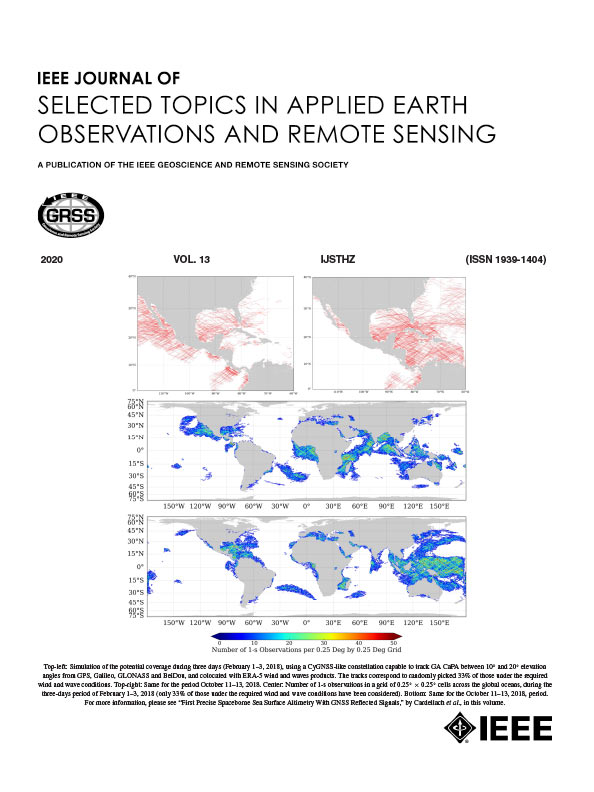Wind-Concerned Sea Ice Detection and Concentration Retrieval From GNSS-R Data Using a Modified Convolutional Neural Network
IF 4.7
2区 地球科学
Q1 ENGINEERING, ELECTRICAL & ELECTRONIC
IEEE Journal of Selected Topics in Applied Earth Observations and Remote Sensing
Pub Date : 2025-03-11
DOI:10.1109/JSTARS.2025.3549383
引用次数: 0
Abstract
Spaceborne global navigation satellite system reflectometry method has been increasingly utilized for sea ice parameters retrieval. The coupling effects between wind speed and retrieval parameters was not considered in both traditional threshold-based methods and neural network models. To address this, a wind-concerned convolutional neural network (WCNN) model for sea ice detection and concentration retrieval is proposed. The model is based on convolutional layers for the feature extraction from delay-Doppler maps, along with fully connected layers for fusing the flattened feature map and wind speed parameters. After data training and testing, the WCNN model achieved sea ice concentration (SIC) retrieval accuracies with RMSE values of 8.61% in the Antarctic and 11.70% in the Arctic, with correlation coefficients of 0.97 in both regions. The sea ice detection accuracy reached 98.19% and 97.08%, respectively. In summary, the comparison of WCNN SIC retrieval performance across varying wind speeds demonstrates that incorporating wind speed data into the WCNN model significantly reduces the misclassification of seawater as sea ice in low wind conditions (0–10 m/s) and lowers the misclassification of sea ice as seawater in high wind conditions (10–20 m/s). Furthermore, the spatiotemporal distribution characteristics of the retrieval results, the advantages and weaknesses of the model are discussed.基于改进卷积神经网络的GNSS-R数据风相关海冰检测与浓度反演
星载全球导航卫星系统反射法在海冰参数反演中的应用越来越广泛。传统的阈值方法和神经网络模型均未考虑风速与反演参数之间的耦合效应。为了解决这一问题,提出了一种与风相关的卷积神经网络(WCNN)海冰检测和浓度反演模型。该模型基于卷积层,用于从延迟多普勒图中提取特征,以及用于融合平坦特征图和风速参数的全连接层。经过数据训练和测试,WCNN模型的海冰浓度(SIC)反演精度在南极和北极分别为8.61%和11.70%,相关系数均为0.97。海冰探测精度分别达到98.19%和97.08%。综上所述,不同风速下WCNN SIC检索性能的比较表明,将风速数据纳入WCNN模型可显著降低低风条件(0-10 m/s)下海水作为海冰的误分类,降低高风条件(10-20 m/s)下海冰作为海水的误分类。讨论了检索结果的时空分布特征、模型的优缺点。
本文章由计算机程序翻译,如有差异,请以英文原文为准。
求助全文
约1分钟内获得全文
求助全文
来源期刊
CiteScore
9.30
自引率
10.90%
发文量
563
审稿时长
4.7 months
期刊介绍:
The IEEE Journal of Selected Topics in Applied Earth Observations and Remote Sensing addresses the growing field of applications in Earth observations and remote sensing, and also provides a venue for the rapidly expanding special issues that are being sponsored by the IEEE Geosciences and Remote Sensing Society. The journal draws upon the experience of the highly successful “IEEE Transactions on Geoscience and Remote Sensing” and provide a complementary medium for the wide range of topics in applied earth observations. The ‘Applications’ areas encompasses the societal benefit areas of the Global Earth Observations Systems of Systems (GEOSS) program. Through deliberations over two years, ministers from 50 countries agreed to identify nine areas where Earth observation could positively impact the quality of life and health of their respective countries. Some of these are areas not traditionally addressed in the IEEE context. These include biodiversity, health and climate. Yet it is the skill sets of IEEE members, in areas such as observations, communications, computers, signal processing, standards and ocean engineering, that form the technical underpinnings of GEOSS. Thus, the Journal attracts a broad range of interests that serves both present members in new ways and expands the IEEE visibility into new areas.

 求助内容:
求助内容: 应助结果提醒方式:
应助结果提醒方式:


